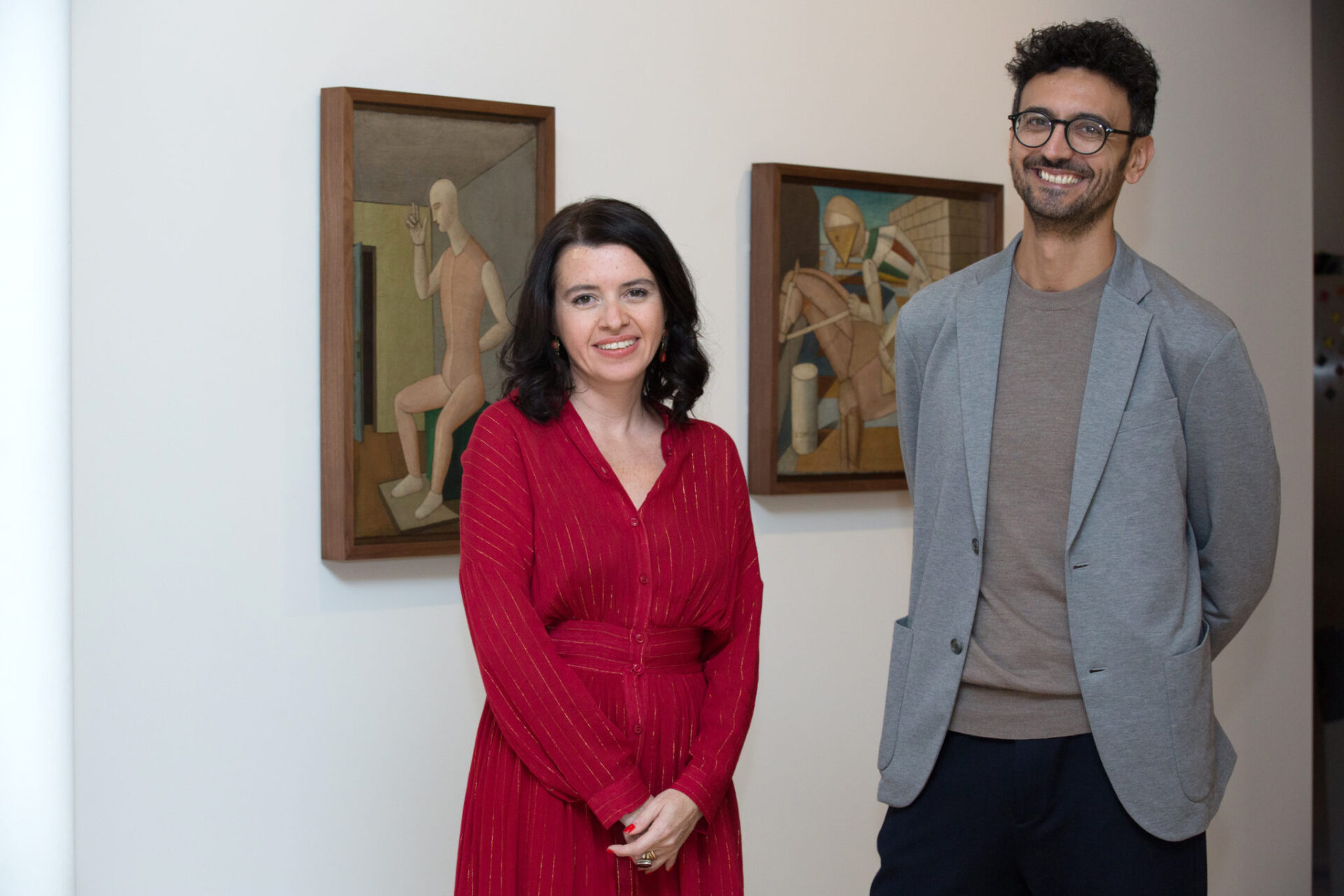After introducing our 3 fall interns , we wanted to take some time to present to you our brilliant fall fellows: Antonio David Fiore, and Erica Bernardi.
–What is your favorite artwork from the Metaphysical Masterpieces show at CIMA and why?
ADF: Mario Sironi’s urban landscape with a dome. I could stare at it for ages, losing myself in the dark blue of the sky, caressing with my imagination the surprisingly gentle curves of the solitary cloud high above. This is a painting that gives me a profound sense of loneliness, and at the same time tenderness: like the set of a dream from where lost familiar faces have just disappeared behind dark windows and mysterious corners. I am fascinated by the high point of view chosen by Sironi: it looks to me like the sight of a resigned god, amazed and at the same time skeptical about the greatness and misery of human existence.
-Tell me the most interesting thing you have seen so far in NYC.
ADF: This is my first time in New York and, although I have been exposed to American films since I was a child, I was not sure what to expect. I was amazed at the scale and vastness of the metropolis, which had a huge effect on me. It is difficult to pick up one aspect: I would say the bridges spanning the East River (I walk almost everyday over the Williamsburg Bridge): they are absolutely magnificent pieces of engineering, rising up above the water, penetrating deep into the urban textures of the two shores, carrying people from one side to the other on their powerful metallic bones.
-How did you first become interested in art history?
ADF: Looking at my sister’s school books. I became captivated by the images I saw in her Art History manual, and I developed a desire to look at the real things, and to know more about them. I have no interest in owing works of art; my way of ‘possessing’ them, is through observation and reflection, an emotional and intellectual experience.
-If you weren’t a Ph.D candidate, what would you be doing instead?
ADF: Luckily enough, I am not a Ph.D candidate anymore, having passed my Viva last November! What I am doing now is partly what I was hoping for: a working/studying experience in the USA that allows me to experience different ways of approaching the discipline, and in general a new context to explore with nice and interesting people to meet.
-What do you like to do when you are not working?
If you want an answer to this question, please come to CIMA’s exhibition when I am delivering a guided tour. I would be pleased to meet and chat about the stunning works featured in the show, and also about myself, in case you are interested…

-How did you first become interested in art history?
EB: When I was a child I had family friends who were in the field of art history. Mainly I frequented an old sick painter named Alberto Diramati that lived near my home in a little village in Piedmont. When I returned from school, my favorite pastime was going to his place and watching him while he painted. I stood behind him, very silent, he didn’t like noise, and I could spend hours this way. In my childhood there was also a friend of his, an architect from Milan, Giacomo Scarpini, that took me with him to exhibitions. I can perfectly remember that with him I visited a lot of very different exhibits, but the one that left the most permanent memory in my mind was the exposition about American art 1940-1960 at the Lingotto in Turin (1990). On this occasion I bought a lot of posters of Pollock, Sam Francis and Gorky paintings that I had hung up in my room for a long time.
-When was your first time in New York? Was surprised you the most about this city?
EB: This is my first time in New York. There are a lot of things that surprise me every day, like the landscapes, this forest of cement and glass, the similarity with the set scenario of a lot of my favorite films, and the museums of course. But the thing that I prefer is the modernity of New York, and I’m talking about a social modernity, in costumes and uses. This is not only America, it’s the world: New York is a melting pot that makes everyone more free than they would be in other places. I wish that, in a such terrible political moment for the entire world, we can hope for a future where everyone can be free to be themselves.
-Best 3 museums or art sites worldwide according to your taste
EB: The Metropolitan Museum in New York, the Louvre in Paris and the Pinacoteca di Brera in Milan, if I think big museums. But I really also like house museums like Villa I Tatti in Florence, Casa Boschi di Stefano in Milan and the Isabella Stuart Gardner Museum in Boston.
-Which city in Italy are you from? How would you describe it, using three words?
EB: I was born in Varallo Sesia, a very little village in the North of Italy, full of art. In fact, Gaudenzio Ferrari was born there; he was a Renaissance painter that worked a lot in the Sacro Monte, a very particular place that’s like an itinerary with 43 chapels about the Christ’s passion.
-If you could purchase any painting, which one would it be? Why? And where would you put it in your apartment?
EB: I would like to have the Sant’Anna cartone of Leonardo da Vinci right in front of my bed.
